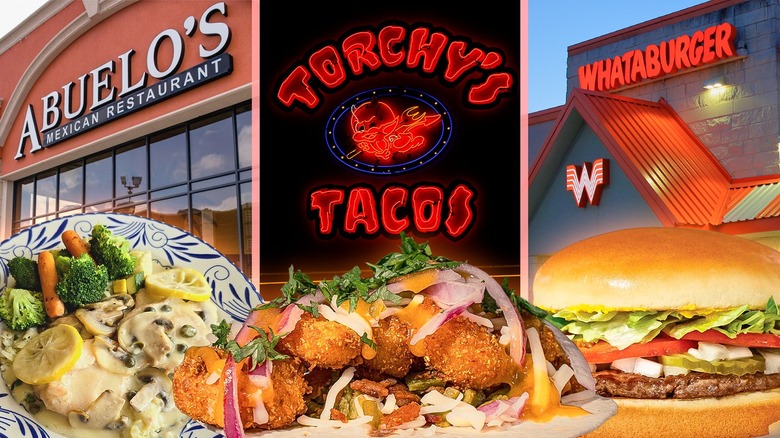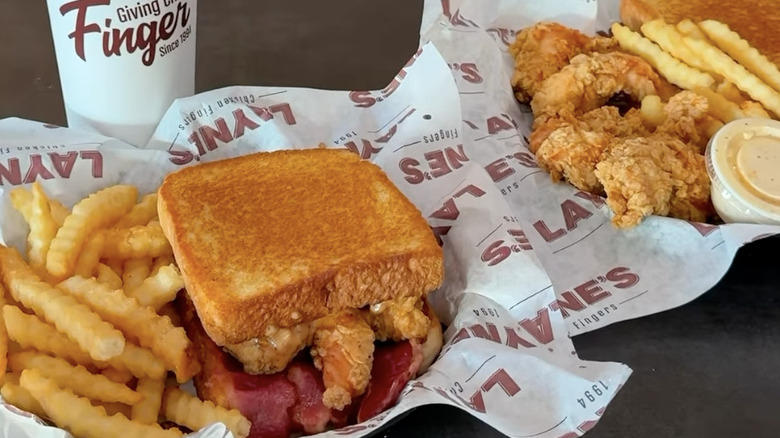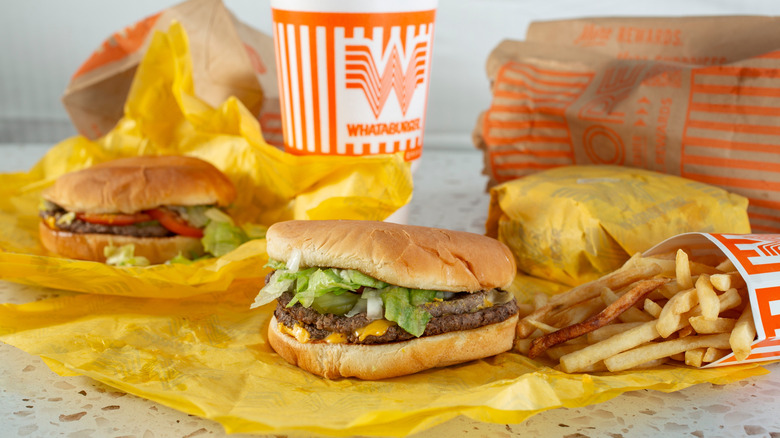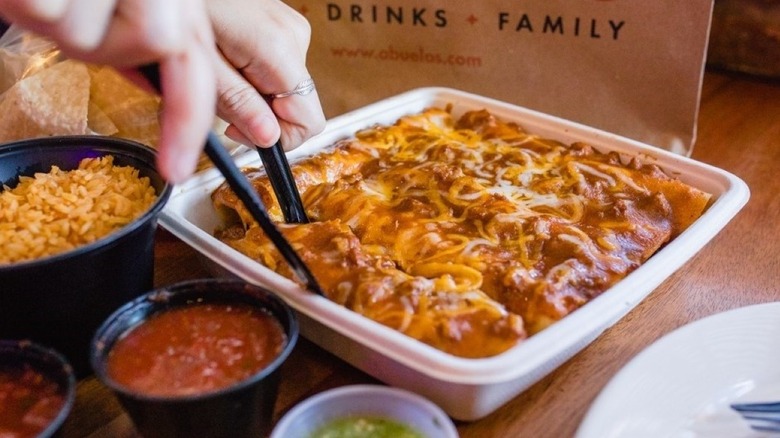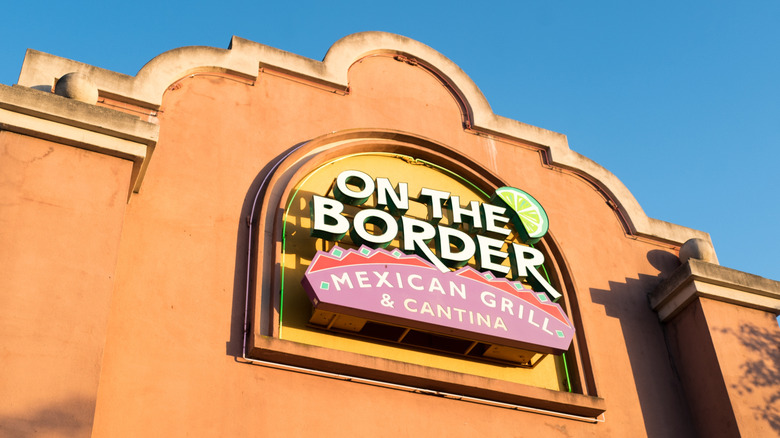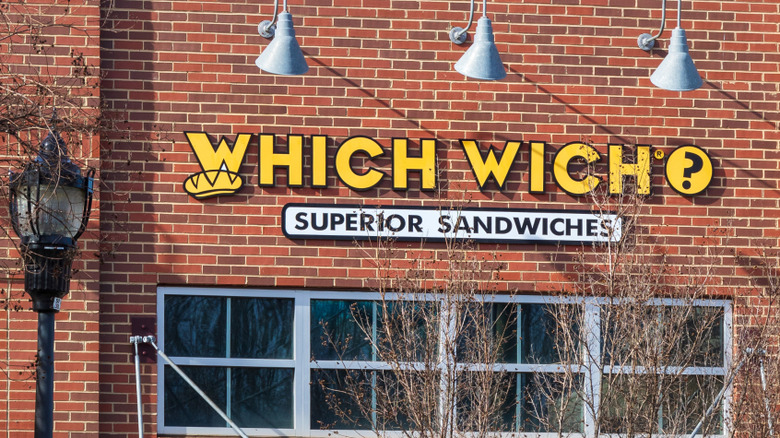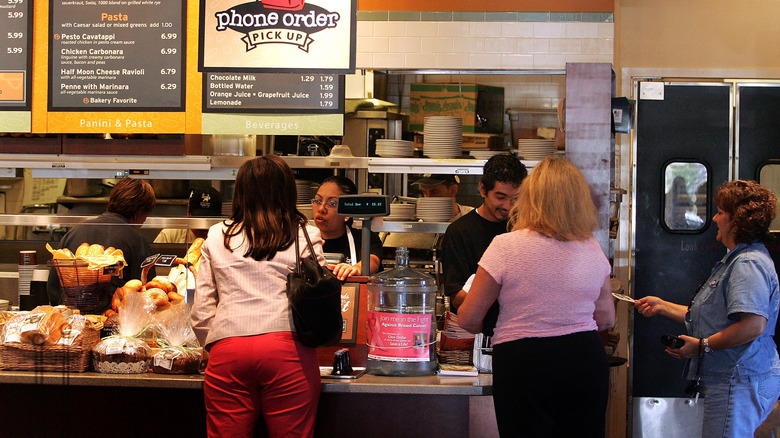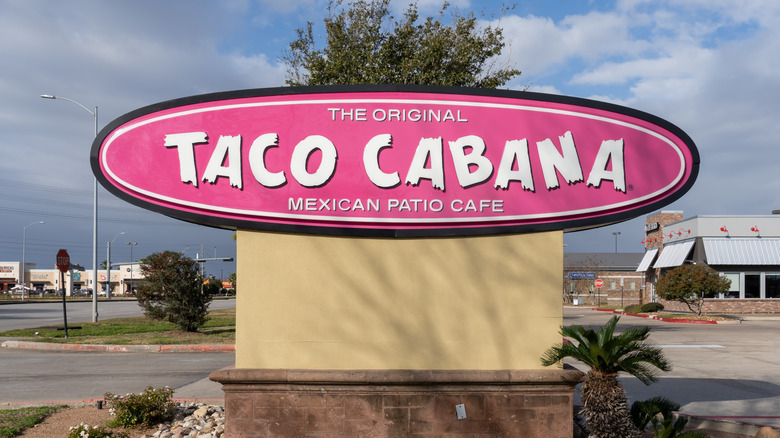6 Texas-Based Restaurant Chains That Are Rapidly Expanding And 6 That Are Struggling
Of all the regions across the U.S. that can claim a bountiful, fertile, and imaginative food culture, Texas is right at the top of the list. They do things bigger in Texas, so the saying goes, and the massive state has given the rest of the country and the world a lot of remarkable food, including hearty beef dishes, a distinctive barbecue tradition, and popular Tex-Mex cuisine, to cite just a few examples.
Texas also has a large population and a robust economy, meaning that in-state restaurant companies have the means and motivation to expand across the country. However, several Texan chain eateries are starting to come to the end of their arc, it would seem. Several Texas-based restaurant chains once found nationwide are slowly but surely trickling back to smaller operations in their home state.
Here are some of the Lone Star State's biggest movers and shakers in fast food and sit-down restaurants, as well as those that are having a hard time staying afloat.
Expanding: Layne's Chicken Fingers
Spurred by the ongoing chicken sandwich wars, many fried chicken chains are expanding in 2025 and in the years to come. Restaurants that focus on chicken strips and tenders are particularly successful and on the up-and-up. Along with Huey Magoo's and Raising Cane's, Texas's own Layne's Chicken Fingers is taking the humble boneless strip to new heights.
Layne's Chicken Fingers is enjoying 67% year-over-year sales growth and a 50% year-over-year increase in units. The menu is small and simple, revolving around chicken fingers, fries, Texas toast, and dipping sauces, as well as shakes and chicken sandwiches. Founded in 1994, Layne's didn't start franchising until 2021, but within four years, it had already opened its 30th outlet. With plans in place for new restaurants in Arkansas, Wisconsin, and Ohio, Layne's Chicken Fingers is on track to hit 80 eateries by 2026.
Struggling: TGI Friday's
When one thinks of "American food," they might think of a place like TGI Fridays. The Dallas-headquartered chain started out as a hip singles bar in New York in 1965, before gradually changing into a family-friendly place that still sold drinks but mostly burgers, appetizers, and other bar food in a loud and festive atmosphere. A pioneer in the sit-down, casual dining concept, there were 600 or so TGI Fridays at the restaurant's height of popularity and success in 2008.
As of November 2024, TGI Fridays constituted 39 company-owned restaurants in the U.S., plus another 122 outlets operated by franchisees. That's when the main operation filed for Chapter 11 bankruptcy protections, seeking assistance as it navigated $37 million in debt against less than $6 million in accessible funds. In addition to taking measures to sell off its assets to pay down its bills, independent operators faced paying down another $50 million in debts. Following some more double-digit closures in the Midwest and the northeastern U.S., TGI Fridays was left with 133 total restaurants.
Expanding: Whataburger
Before the gigantic chains emerged as national entities in the mid-20th century, burgers and fries were dominated by regional juggernauts. In large swathes of the South, and in Texas especially, the big name in grilled beef on a bun was Whataburger. In 1950, Harmon Dobson started cooking fresh beef and loading it up with a wide selection of toppings in Corpus Christi, Texas. Burgers, patty melts, and chicken sandwiches are some fan favorites, while Whataburger's ketchup is better than other fast food chains'. Soon, Whataburger became a Texas institution open 24 hours a day.
In the summer of 2020, when other restaurants were severely hurt by COVID-19-era lockdowns and economic issues, Whataburger announced an assertive growth plan. At the time, it had a presence in 10 states, and it immediately planned to open 40 new outlets by the end of 2021. By 2025, Whataburger had restaurants in 17 states and 1,130 overall. The expansion continues, too. Whataburger recently entered the Kansas City metropolitan area, as well as North Carolina and South Carolina.
Struggling: Abuelo's
Abuelo's is Spanish for "Grandfather's," and that conjures up food that's traditional and "homemade." In 1989, Abuelo's opened in Amarillo, Texas, with a menu of favorites developed from the family cookbook of head chef Luis E. Sanchez. Over time, and as it expanded into Texas and other states, Abuelo's morphed into a Tex-Mex establishment, serving up big platters of broadly popular stuff like tacos, chimichangas, and tortilla soup.
Abuelo's was a successful venture — at its peak, the chain had 40 restaurants. However, revenues stopped growing in 2009, and COVID-19 compounded the chain's financial issues. At the end of 2024, 20 Abuelo's were left, and one year later, just 16. Abuelo's filed for bankruptcy, but remains open as it tries to restructure and recover.
Expanding: Summer Moon Coffee
Caffeine remains Americans' stimulant of choice, and there's a coffee chain out of Texas encroaching on the likes of Starbucks, Black Rock, and Dutch Bros. Summer Moon Coffee got started in 2002 as a family-run roasting business in Texas Hill Country, which led to a coffee bar in Austin opening in 2005.
Initially, the founders allowed only friends to open other coffee bars bearing the Summer Moon name before granting the public at large to bring the company's wares to the rest of Texas and beyond. Summer Moon Coffee's drinks taste a bit different from other major coffeehouses, because the wood makes it good. The beans are roasted in oak-fired vessels, and when brewed, are recommended to be paired with the chain's signature, specially formulated sweet cream it calls Moon Milk.
By 2023, Summer Moon Coffee comprised 36 units. Just a year later, it had 58, making it the fastest-growing coffee chain in the U.S.
Struggling: On the Border
The Irving, Texas-based restaurant chain may call itself a "Mexican Cantina and Grill," but On the Border leans heavily on the Tex-Mex elements since opening in Dallas in 1982. There's a focus on meat, which is prepared in special marinades and cooked on mesquite-fired grills, which is the foundation of all manner of tacos, burritos, and fajitas.
At the height of its appeal, there were more than 150 On the Border Mexican Cantina and Grill restaurants, primarily in the United States. By 2020, the future didn't look good for the chain, and in an attempt to prevent any further contraction, On the Border hired a new CEO, embraced digital sales, and tried to update its menu and branding. All that failed to bring in new business, and in 2025, On the Border filed for bankruptcy.
Seeking bankruptcy protections, the chain had closed so many stores that it had shrunk to a collective of 60 company-owned eateries and 20 franchised ones, and it faced $25 million in debt with about 10,000 vendors and creditors left unpaid. The dire situation was resolved somewhat when Pappas Restaurants, which operates Pappasitas Cantina, bought On the Border outright after investing $10 million in the chain's parent company.
Expanding: Chili's
Perhaps the definitive casual dining restaurant, serving a large menu of burgers, Tex-Mex food, appetizer platters, and giant cocktails, Dallas-based Chili's was massive in the '90s and 2000s, growing to a 1,312-unit chain earning more than $4 billion a year by 2008, when the Great Recession arrived.
Less disposable income meant less dining out for millions of Americans, and Chili's closed 80 restaurants in the ensuing years. However, in 2022, parent company Brinker International brought in a new CEO to reverse its fortunes. Since then, Chilli's has grown while most competitors continue to struggle through the 2020s. In 2024, its quarterly revenues grew by about 15% over a year. The chain cut about a fifth of its menu and spent the saved revenue on renovations across hundreds of outlets.
Bargain combo meals have been Chili's real savior. Its "3 For Me" program offers restaurant-quality meals for the price of fast food; its burger, fries, bottomless chips, and salsa with a refillable soft drink costs just $10.99. The average Chili's enjoyed sales volume increases of half a million dollars, while the entire Chili's operation is looking to expand. Currently and historically concentrated in Texas, Florida, and California, there will soon be lots more Chili's eateries in the northeast and the Pacific Northwest.
Struggling: Which Wich
Inspired by a love of childhood bagged lunches and a sandwich-heavy Peanuts cookbooks, long-time restaurant developer Jeff Sinelli found a defunct Subway in downtown Dallas and installed a new business of his own design: Which Wich Superior Sandwiches. In 2005, after only about two years, Sinelli took Which Wich deep into franchise land. By 2017, Sinelli had overseen the opening of a total of 430 Which Wich shops nationwide, earning numerous accolades from the restaurant industry and the media for navigating the crowded and competitive fast food marketplace.
Key to its success was an extensive menu that offered more than the competition. Which Wich sells four kinds of turkey sandwiches, five seafood options, five vegetarian selections, five classic Italian choices, and its signature Wicked sandwich, which packs five meats and three cheeses into one roll.
Such rapid growth couldn't and wouldn't last. Despite serving some of the best tuna salad among all sandwich chains and using some of the sandwich industry's best bread, Which Wich has had a tough time since COVID. By early 2023, Which Wich was down from 430 to 227 outlets. About a year and a half later, that figure had fallen to 162.
Expanding: Torchy's Tacos
Torchy's Tacos differentiates itself from the many other Mexican-style and Tex-Mex restaurants in Texas by touting its homemade fare. The restaurants make churros, tortillas, and queso onsite. It's grown quickly since 2006, when the business was a trailer touring Austin, Texas, handing out free taco samples across the city.
Today, Torchy's is a chain of 120 restaurants, specializing in beef, pork, and seafood tacos that incorporate cuisine beyond Texas and Mexico and which have been given colorful names like "The Hogfather," "Mr. Orange," "and "The FoSho." Most Torchy's Tacos are in Texas, but the restaurant has a significant presence in Colorado, Arizona, Florida, Virginia, and the upper Midwest.
In October 2025, Torchy's Tacos revealed an extensive expansion plan. Within five years, the taco company aims to reach the 200th restaurant milestone, growing in existing markets and opening stores in new states.
Struggling: Corner Bakery Café
Everyone loves a little spot down the street where they can grab a cup of coffee and a muffin, and it's that theory that fueled Corner Bakery Café. Launched in Chicago in 1991, Corner Bakery Café would later relocate its corporate offices to Dallas. It predates the rise of competitors like Panera and Starbucks, offering a menu of coffee, sandwiches, and baked goods.
By 2019, there were 182 Corner Bakery Café shops across the United States. However, the COVID-19 lockdowns the following year devastated the business. Roark Capital sold Corner Bakery Café to restaurant franchiser Jay Pandya, but the company still wasn't able to pay its substantial bills, and unpaid vendors filed lawsuits to get what they were owed. With $43 million of loan payment bills built up by 2022, restaurant operator SSCP Management bought that debt and the chain, and then declared bankruptcy for Corner Bakery Café. As of 2025, 95 shops are still pouring coffee and baking cookies.
Expanding: Taco Cabana
In 1978, Felix and Billie Jo Stehling, who ran the Crystal Pistol bar in San Antonio, took over the lease of an adjacent, modest Dairy Queen for its lot, then decided to use the building to sell tacos, hiring renowned local cook and restaurateur Margie Lopez Abonce to develop the first menu at what they called Taco Cabana. The place became a hit when the Stehlings opened it 24 hours with a dining patio, both of which became essential parts of the Taco Cabana experience.
The Stehling family left the company in 1994, at which point about 20 Taco Cabanas were open. Over the next two decades, the chain grew under new management, plastering Texas with 144 total outlets. In 2023, after its acquisition by multi-restaurant mega-franchiser Yadav Enterprises, Taco Cabana announced ambitious growth plans that would take it from a regional Mexican-inspired chain into a national one. By 2033, it aims to open over 1,000 new restaurants, beginning with the suburbs of Texas cities and New Mexico, before venturing into six new states.
Struggling: El Chico Cafe
El Chico Mexican Cafe helped popularize Mexican and Mexican-inspired food across the United States. The cafe began as a small family restaurant run by Mexican immigrants since 1928, with the first official location opening in Dallas in 1940. More locations opened in Texas and neighboring states until there were 75 El Chico restaurants, at which point industrial operation Campbell Taggart purchased the chain.
Six years later, Gilbert Cuellar, a member of the family that launched El Chico, bought it back and set about expanding the restaurant even more, building it into one of the biggest names in Tex-Mex by focusing on the chain and that cuisine's signature items: chili and tamales.
El Chico became overshadowed by all the other Tex-Mex restaurants it helped inspire. It's still a multi-unit operation, but increasingly less so. As of 2025, only 13 El Chico restaurants are still open, primarily in Texas and nearby Oklahoma.
